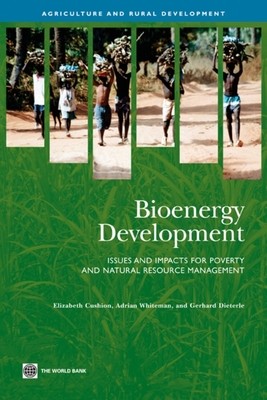
- We will send in 10–14 business days.
- Author: Elizabeth Cushion
- Publisher: World Bank Publications
- ISBN-10: 0821376292
- ISBN-13: 9780821376294
- Format: 15 x 22.6 x 1.3 cm, minkšti viršeliai
- Language: English
- SAVE -10% with code: EXTRA
Reviews
Description
Bioenergy has been critically important since our ancestors first used wood to cook their food and stay warm at night. Traditional forms of bioenergy, firewood and cow dung patties, remain primary fuel sources for many rural and poor people. More modern sources of bioenergy--including ethanol and biodiesel for transport and wood pellets for heating, among many others--offer great promise but generate great controversy. This book gives an overview of bioenergy developments. It examines the main issues and possible socioeconomic implications of these developments, as well as their potential impacts on land use and the environment, especially with respect to forests. The authors present an introduction to bioenergy, provide a background and overview of solid biomass and liquid biofuels, and examine the opportunities and challenges at the regional and country levels. They also examine potential impacts for specific types of bioenergy. 'Bioenergy Development' does not attempt to be definitive on such subjects as the impact of bioenergy on food prices, but it does suggest the tradeoffs that need to be examined when considering bioenergy policies. The authors offer five main findings: - Solid biomass will continue to provide a principal source of energy and should not be overlooked. - There will be major land-use implications resulting from bioenergy developments. - It is critical to consider tradeoffs--including those related to poverty, equity, and the environment--when considering bioenergy policies. - There is considerable potential for an increased use of forestry and timber waste as a bioenergy feedstock. - The climate change impacts of bioenergy development are uncertain, and highly specific to location and feedstock.
EXTRA 10 % discount with code: EXTRA
The promotion ends in 21d.13:28:42
The discount code is valid when purchasing from 10 €. Discounts do not stack.
- Author: Elizabeth Cushion
- Publisher: World Bank Publications
- ISBN-10: 0821376292
- ISBN-13: 9780821376294
- Format: 15 x 22.6 x 1.3 cm, minkšti viršeliai
- Language: English English
Bioenergy has been critically important since our ancestors first used wood to cook their food and stay warm at night. Traditional forms of bioenergy, firewood and cow dung patties, remain primary fuel sources for many rural and poor people. More modern sources of bioenergy--including ethanol and biodiesel for transport and wood pellets for heating, among many others--offer great promise but generate great controversy. This book gives an overview of bioenergy developments. It examines the main issues and possible socioeconomic implications of these developments, as well as their potential impacts on land use and the environment, especially with respect to forests. The authors present an introduction to bioenergy, provide a background and overview of solid biomass and liquid biofuels, and examine the opportunities and challenges at the regional and country levels. They also examine potential impacts for specific types of bioenergy. 'Bioenergy Development' does not attempt to be definitive on such subjects as the impact of bioenergy on food prices, but it does suggest the tradeoffs that need to be examined when considering bioenergy policies. The authors offer five main findings: - Solid biomass will continue to provide a principal source of energy and should not be overlooked. - There will be major land-use implications resulting from bioenergy developments. - It is critical to consider tradeoffs--including those related to poverty, equity, and the environment--when considering bioenergy policies. - There is considerable potential for an increased use of forestry and timber waste as a bioenergy feedstock. - The climate change impacts of bioenergy development are uncertain, and highly specific to location and feedstock.


Reviews